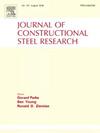Prediction of load-bearing capacity of sigma section CFS beam-column members using ensemble and deep learning algorithms
IF 4
2区 工程技术
Q1 CONSTRUCTION & BUILDING TECHNOLOGY
引用次数: 0
Abstract
In this study, the bearing capacity of CFS sigma-section (S) beam-column members are predicted using three different ensemble learning (EL) algorithms and three deep learning (DL) algorithms. A validated detailed finite element model was created, and a comprehensive dataset was generated by performing 2552 finite element analyzes (FEAs) with different cross-sectional properties and loading conditions. The dataset was divided into train (80 %) and test (20 %) sets and hyperparameter optimization was performed on the train set using the GridSearchCV method. Then, analyses were performed on train and test sets. In addition, SHAP, ICE and PDP analyses were performed to determine the effect of input characteristics. The most accurate model for predicting the load-bearing capacity of the members is Extreme Gradient Boosting Regressor (XGR) with an R2 value of 0.995. According to SHAP analysis identified major eccentricity and local buckling critical load factor as key influencing parameters. As a result of the study, the load-bearing capacity of S-section CFS members under axial force and uniaxial\biaxial bending were predicted with high accuracy. Finally, using the computational speed of the XGR model, the load bearing capacity of S-section CFS members under axial force and uniaxial\biaxial bending was estimated in less than one second with the help of a designed graphical user interface.
求助全文
约1分钟内获得全文
求助全文
来源期刊

Journal of Constructional Steel Research
工程技术-工程:土木
CiteScore
7.90
自引率
19.50%
发文量
550
审稿时长
46 days
期刊介绍:
The Journal of Constructional Steel Research provides an international forum for the presentation and discussion of the latest developments in structural steel research and their applications. It is aimed not only at researchers but also at those likely to be most affected by research results, i.e. designers and fabricators. Original papers of a high standard dealing with all aspects of steel research including theoretical and experimental research on elements, assemblages, connection and material properties are considered for publication.
 求助内容:
求助内容: 应助结果提醒方式:
应助结果提醒方式:


